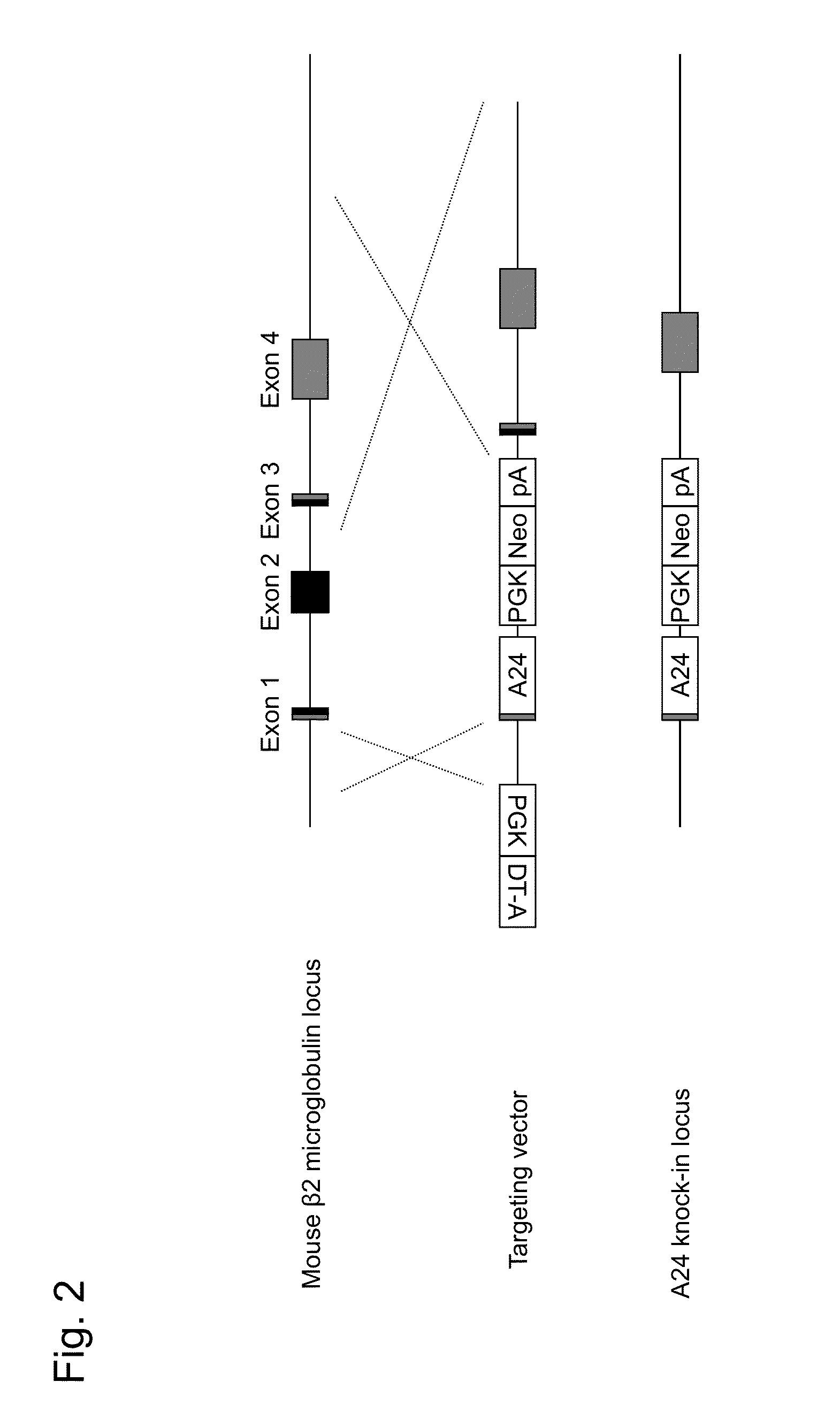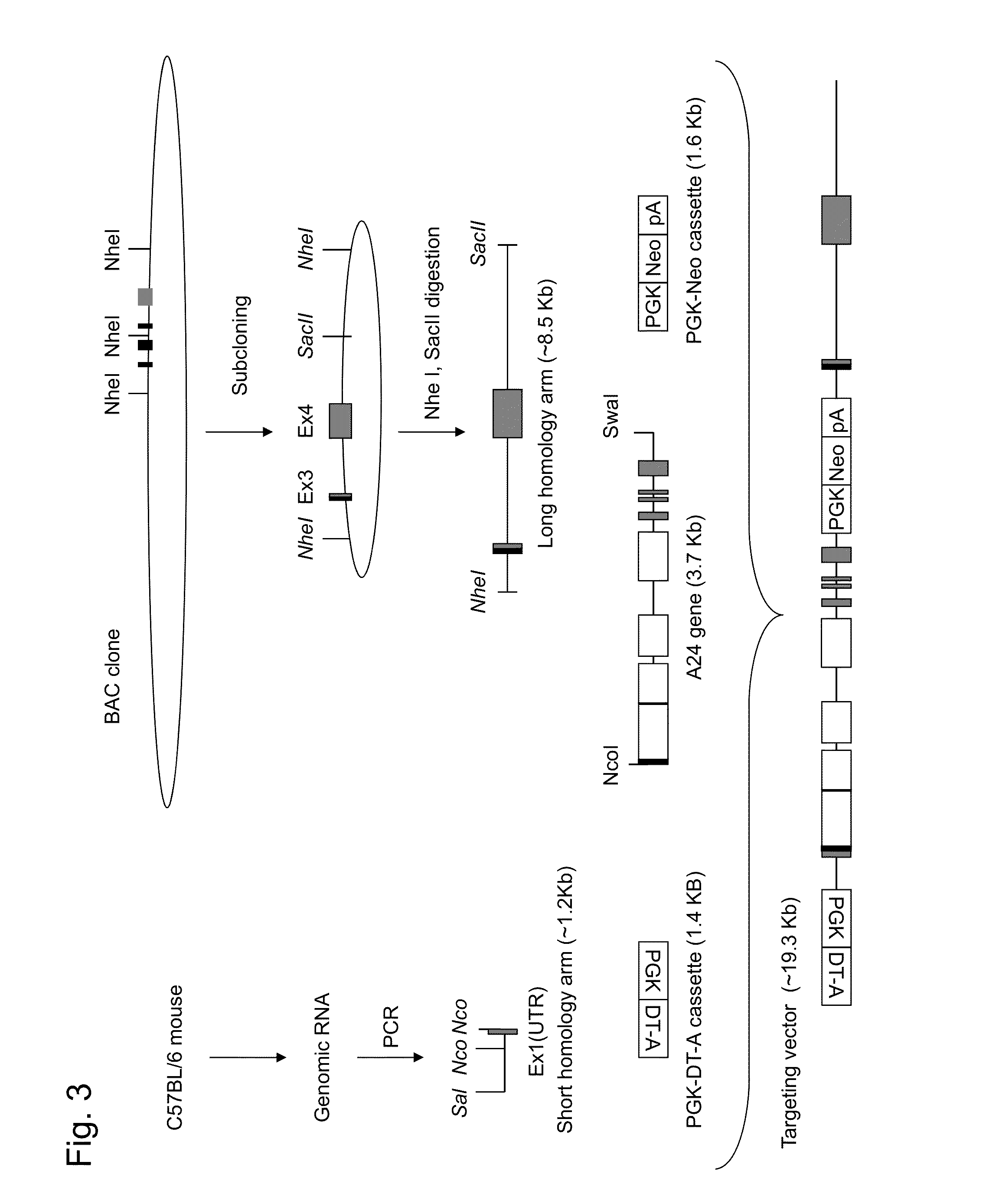HLA class i-expressing non-human animal
a non-human animal and hla technology, applied in the field of hla-expressing non-human animals, can solve the problems of insufficient recognition of 3 region by transgenic mice, limited hla-restricted ctl induction, and inability to use mice as in vivo evaluation models for human vaccine developmen
- Summary
- Abstract
- Description
- Claims
- Application Information
AI Technical Summary
Benefits of technology
Problems solved by technology
Method used
Image
Examples
example 1
Cloning of Partial Sequence of HLA-A2402 Gene
[0203]In order to prepare artificial chimeric genes, at the outset, a gene fragment containing α1 and α2 regions was cloned via PCR using genomic DNA of the SW620 human tumor cell line as a template on the basis of the sequence information for HLA-A2402 (GenBank Accession No. L47206.1). In such a case, a sequence encoding a peptide of 10 amino acids including a BamHI recognition sequence was added to the N terminus, and the BglII recognition sequence was added to the intron 3 sequence at the C terminus, so as to bind the gene fragment to human β2 microglobulin gene and mouse H-2 α3 region. Specifically, PCR was carried out using the primers shown below, and a 867-bp DNA fragment modified as described above was obtained.
Bam-10AA-A24-F1:(SEQ ID NO: 18)5′-GGATCCGGCGGAGGCGGCTCGGGTGGCGGCGGCGGCTCTGGATCTCCCACTCCATGAGGTATTTCTCC-3′Bgl-A24-R1: (SEQ ID NO: 19)5′-AGATCTACAGGCGATCAGGTAGGCGCCCC-3′
example 2
Cloning of cDNA of Human β2 Microglobulin
[0204]Subsequently, cDNA of human β2 microglobulin was cloned via RT-PCR using total RNA prepared from the HepG2 human tumor cell line as a template on the basis of the sequence information for cDNA of human β2 microglobulin (GenBank Accession No. NM_004048.2). In such a case, a sequence encoding a peptide of 5 amino acids including a BamHI recognition sequence was added to the C terminus, so as to bind the cDNA fragment to HLA α1 and α2 regions. In order to knock-in the artificial chimeric gene into a site corresponding to the first methionine of mouse β2 microglobulin and express the artificial chimeric gene on a cell membrane upon normal processing, a leader sequence of HLA-A24 comprising an NcoI recognition sequence was added to the N terminus. Specifically, PCR was carried out using the primers shown below, and a 386-bp DNA fragment modified as described above was obtained.
Nco-A24L-hB2m-F1:(SEQ ID NO: 20)5′-CCATGGCCGTCATGGCGCCCCGAACCCTCG...
example 3
Cloning of Partial Sequence of Mouse H-2Db Gene
[0205]On the basis of sequence information for mouse H-2Db (GenBank Accession No. M37681.1), regions downstream of α3 region including the intracellular domain (i.e., exons 4 to 8 and introns 3 to 7) were cloned via PCR using genomic DNA of the C57BL6 / N mouse as a template. In order to bind the sequence to the HLA α1 and α2 regions and to facilitate vector construction, the BamHI recognition sequence was added to intron 3 at the N terminus and, for example, the SwaI recognition sequence was added to the C terminus. Specifically, PCR was carried out using the primers shown below, and a 2494-bp DNA fragment modified as described above was obtained.
Bam-H2Db-F1: (SEQ ID NO: 22)5′-GGATCCTGTGTGACATACCTGTACCTTGTC-3′Swa-H2Db-R1: (SEQ ID NO: 23)5′-ATTTAAATCTAGTTGAGTCTCTGATCTTTAGCCCTAGG-3′
PUM
| Property | Measurement | Unit |
|---|---|---|
| period of time | aaaaa | aaaaa |
| concentration | aaaaa | aaaaa |
| concentration | aaaaa | aaaaa |
Abstract
Description
Claims
Application Information
 Login to View More
Login to View More - R&D
- Intellectual Property
- Life Sciences
- Materials
- Tech Scout
- Unparalleled Data Quality
- Higher Quality Content
- 60% Fewer Hallucinations
Browse by: Latest US Patents, China's latest patents, Technical Efficacy Thesaurus, Application Domain, Technology Topic, Popular Technical Reports.
© 2025 PatSnap. All rights reserved.Legal|Privacy policy|Modern Slavery Act Transparency Statement|Sitemap|About US| Contact US: help@patsnap.com



